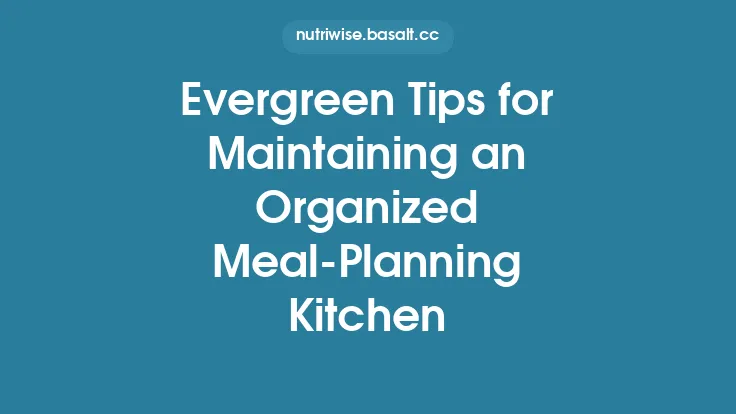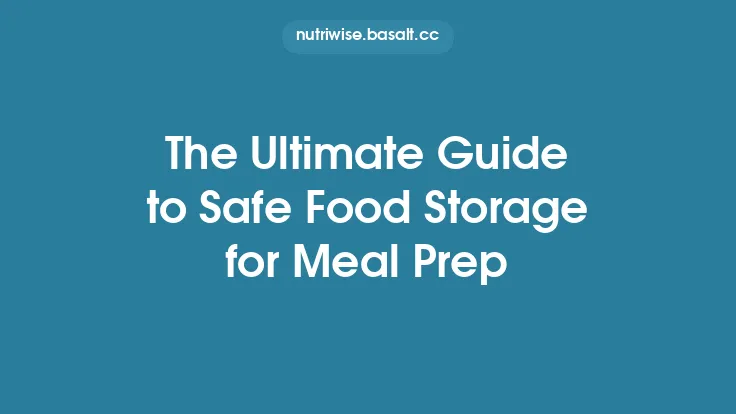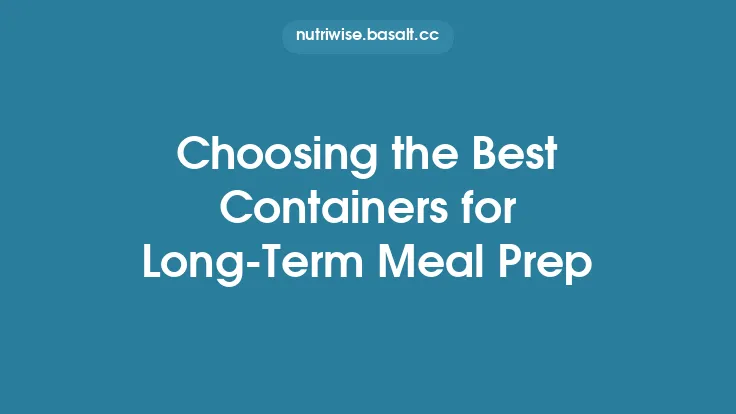Smart meal preparation is more than just chopping vegetables and portioning protein; it’s a systematic approach that blends nutrition, time‑management, and environmental stewardship. By integrating sustainable containers into every step of the process, home cooks can streamline their routines, keep food safe and fresh, and dramatically cut down on single‑use waste. Below is a comprehensive guide that walks you through the practicalities of pairing the right containers with your meal‑prep workflow, organizing your kitchen for maximum efficiency, and measuring the true impact of your choices.
Understanding the Material Spectrum: From Glass to Stainless Steel and Beyond
Sustainable containers come in a variety of materials, each with distinct thermal properties, durability, and environmental footprints. Knowing how these characteristics align with your cooking habits is essential for making informed decisions.
| Material | Thermal Behavior | Microwave/Freezer Compatibility | Seal Integrity | Typical Lifespan | Environmental Notes |
|---|---|---|---|---|---|
| Tempered Glass | Excellent heat resistance; retains temperature well | Safe for microwave, oven (up to ~250 °C), freezer | Often equipped with silicone gaskets for airtight closure | 10‑15 years (if not shattered) | Recyclable indefinitely; low leaching risk |
| Stainless Steel (Food‑grade 18/8) | Conducts heat quickly; does not retain heat as long as glass | Not microwave‑safe; freezer‑safe | Lock‑tight lids with silicone or polymer gaskets | 15‑20 years (or more) | Highly recyclable; low embodied energy after initial production |
| Silicone (Food‑grade) | Flexible; tolerates wide temperature range (‑40 °C to 230 °C) | Microwave, oven, freezer safe | Snap‑fit or screw lids; often airtight | 5‑7 years (subject to tearing) | Durable, but recycling options limited; can be repurposed |
| Bamboo‑Fiber Composites | Moderate heat resistance; best for cold or room‑temp storage | Generally not microwave‑safe; freezer‑safe if reinforced | Press‑fit lids with natural rubber seals | 2‑4 years (depends on wear) | Renewable source; compostable under industrial conditions |
| High‑Density Polyethylene (HDPE) – Recycled | Good barrier to moisture; tolerates moderate heat | Microwave safe if labeled; freezer safe | Snap‑on or screw caps; may require additional gasket | 3‑5 years | Recycled content reduces virgin plastic demand; still a plastic |
When planning your meal‑prep system, consider the temperature profile of each dish. For example, a batch‑cooked soup that will be reheated in the microwave pairs well with tempered glass, while a cold quinoa salad stored for a week can comfortably sit in a stainless‑steel container that resists odor transfer.
Matching Containers to Meal‑Prep Workflows
A one‑size‑fits‑all container strategy often leads to inefficiencies. Instead, map your typical cooking stages—cook, cool, portion, store, reheat—to container types that excel at each phase.
- Bulk Cooking Phase
- Ideal Container: Large, vented stainless‑steel pots or silicone‑lined stockpots.
- Why: They can handle high heat, are easy to deglaze, and the vented lids prevent boil‑over while preserving steam for even cooking.
- Rapid Cooling Phase
- Ideal Container: Shallow tempered‑glass trays (e.g., 1‑inch depth).
- Why: A larger surface area accelerates heat loss, reducing the time food spends in the “danger zone” (4 °C–60 °C) where bacterial growth spikes.
- Portioning Phase
- Ideal Container: Stackable, compartmentalized stainless‑steel or silicone containers with snap‑fit lids.
- Why: Uniform compartments enforce consistent serving sizes, aiding nutritional tracking and minimizing over‑portioning.
- Long‑Term Storage Phase
- Ideal Container: Airtight glass jars with silicone gaskets for dry goods (e.g., cooked grains, beans) and stainless‑steel containers for protein‑rich meals that may be reheated directly.
- Why: Glass provides an excellent barrier against oxygen, while stainless steel resists odor migration over weeks.
- Reheating Phase
- Ideal Container: Microwave‑safe glass or silicone containers with vented lids.
- Why: Venting prevents pressure buildup, and the transparent nature of glass lets you monitor heating progress without opening the lid.
By aligning each step with a purpose‑built container, you reduce the need for transferring food between vessels—a practice that often generates extra cleaning work and increases the risk of cross‑contamination.
Designing a Modular Storage System for Any Kitchen Layout
Even the most thoughtfully selected containers can become a source of clutter if not organized strategically. A modular system leverages uniform dimensions and stacking principles to maximize vertical space while keeping frequently used items within arm’s reach.
- Standardize Base Dimensions
Choose containers that share a common footprint (e.g., 8 × 8 inches). This allows you to stack them like building blocks, regardless of height. Many manufacturers offer “nestable” series that interlock securely.
- Create Zones
- Prep Zone: Keep shallow glass trays and compartmentalized containers on the countertop for immediate post‑cook transfer.
- Cool‑Down Zone: Allocate a lower shelf in the fridge for shallow trays, ensuring air circulation.
- Storage Zone: Reserve the top fridge shelf for airtight glass jars (dry goods) and the middle shelf for protein‑rich meals in stainless steel.
- Reheat Zone: Store microwave‑safe containers near the microwave for quick access.
- Utilize Drawer Inserts
Silicone or bamboo inserts can hold lids upright, preventing them from nesting under containers and making it easier to locate the correct size.
- Label Racks
Simple magnetic or adhesive tags on the exterior of each rack (e.g., “Week 1 – Breakfast”) help you locate meals without opening every container.
A modular approach not only streamlines daily routines but also reduces the time spent searching for the right container, which in turn encourages consistent meal‑prep habits.
Maximizing Shelf Life and Food Safety with Sustainable Containers
While sustainable containers are designed for durability, they also play a pivotal role in preserving food quality. Below are evidence‑based practices that leverage container features to extend shelf life and maintain safety.
- Seal Quality Matters
- Silicone Gaskets: Provide a near‑hermetic seal, limiting oxygen ingress that accelerates oxidation of fats and vitamins.
- Vacuum‑Lock Lids: Some stainless‑steel containers incorporate a manual pump to remove air, achieving vacuum levels comparable to commercial vacuum sealers.
- Temperature Consistency
- Thermal Mass: Glass containers retain temperature longer, slowing the warming of refrigerated foods and reducing condensation, which can foster mold.
- Insulated Stainless Steel: Double‑wall designs keep foods colder for longer periods, especially useful for meals that will be transported to work.
- Moisture Control
- Perforated Lids for Certain Dishes: For items like cooked grains that benefit from a slight release of steam, a lid with a small vent hole prevents sogginess while still protecting against external contaminants.
- Dry‑Box Compartments: Some modular systems include a small, sealed compartment for silica‑gel packets, which absorb excess moisture in the storage environment.
- Avoid Cross‑Contamination
- Dedicated Containers for Raw vs. Cooked: Assign a set of containers exclusively for raw proteins and another for cooked meals. This practice eliminates the need for intensive cleaning between uses and reduces bacterial transfer.
- Rapid Cooling Protocol
- Transfer hot food into shallow glass trays, then place the trays in an ice‑water bath for 5‑10 minutes before sealing. This accelerates the cooling curve, keeping the food out of the bacterial danger zone for a shorter period.
By integrating these safety measures into your routine, you not only protect your health but also reduce food waste caused by premature spoilage.
Smart Labeling and Tracking: Reducing Waste Through Organization
Even the best containers can become sources of waste if you lose track of what’s inside. A systematic labeling strategy, combined with simple tracking tools, helps you consume meals before they expire.
- Color‑Coded Labels
Use a set of reusable, waterproof labels in a gradient (e.g., green for “consume within 3 days,” yellow for “consume within 5 days,” red for “consume within 7 days”). Stick the appropriate label on each container’s lid.
- QR Code Inventory
Generate a QR code for each meal that links to a Google Sheet or a dedicated meal‑prep app. Scanning the code with a smartphone instantly displays the preparation date, ingredients, and suggested consumption window.
- Batch‑Date Stamping
Invest in a small, food‑grade stamp that imprints the date (e.g., “2025‑10‑15”) directly onto the container’s surface. This eliminates the need for separate stickers that can peel off.
- First‑In‑First‑Out (FIFO) Rotation
Store newer meals at the back of the fridge and older meals at the front. A simple “push‑back” shelf system makes this rotation effortless.
These low‑tech yet highly effective methods keep your inventory visible, ensuring that meals are used in a timely manner and reducing the likelihood of forgotten, expired food.
Cleaning, Maintenance, and Longevity: Extending the Life of Your Containers
Sustainable containers are an investment; proper care maximizes their lifespan and preserves their performance.
- Gentle Cleaning Regimen
- Glass: Use a non‑abrasive sponge with mild dish soap. For stubborn stains, a paste of baking soda and water works without scratching.
- Stainless Steel: Avoid chlorine bleach; instead, clean with warm water and a few drops of dish soap. For odor removal, a soak in a solution of 1 part white vinegar to 4 parts water for 15 minutes is effective.
- Silicone: Hand‑wash with a soft brush; high‑temperature dishwasher cycles can degrade silicone over time.
- Seal Maintenance
- Inspect silicone gaskets monthly for cracks or loss of elasticity. If a gasket becomes brittle, replace it—most manufacturers sell replacements at a low cost.
- For metal lids with rubber seals, wipe the seal with a damp cloth after each use to prevent food residue buildup.
- Avoid Thermal Shock
- Do not transfer a hot glass container directly into a cold freezer; allow it to reach room temperature first. Sudden temperature changes can cause micro‑cracks that compromise seal integrity.
- Repair and Upcycle
- Small chips in glass can be repaired with food‑grade epoxy, extending usability.
- Old stainless‑steel containers can be repurposed as pantry organizers for dry goods, or as DIY “soup bowls” for office lunches.
A disciplined maintenance routine not only preserves the functional qualities of your containers but also reinforces the sustainability ethos behind your meal‑prep system.
Environmental Accounting: Measuring the Impact of Your Meal‑Prep Choices
Quantifying the ecological benefits of sustainable containers helps you make data‑driven decisions and communicate your progress to others.
- Carbon Footprint Estimation
Use publicly available life‑cycle assessment (LCA) databases to obtain the embodied carbon (kg CO₂e) for each material. For example, a 1‑liter tempered glass jar typically carries ~0.5 kg CO₂e, while a comparable HDPE container may be ~0.3 kg CO₂e. Multiply by the number of units you own and subtract the avoided emissions from single‑use plastic (average 0.02 kg CO₂e per disposable container).
- Waste Reduction Metrics
Track the number of disposable containers avoided per week. If you replace 10 disposable plastic containers with reusable ones, you prevent roughly 200 g of plastic waste from entering landfills each month.
- Water Usage Savings
Reusable containers require fewer washes than the production of new single‑use packaging. Estimate water savings by comparing the average 2 L of water used per disposable container’s manufacturing process versus the 0.1 L per wash cycle for reusable items.
- Financial Payback Period
Calculate the upfront cost of a sustainable container set and divide by the average cost per disposable container you would have otherwise purchased. Many users see a break‑even point within 6‑12 months, after which the savings become pure environmental gain.
By regularly updating these metrics, you can visualize the tangible outcomes of your meal‑prep strategy and stay motivated to refine your practices.
Integrating Sustainable Containers with Digital Meal‑Prep Planning
Technology can amplify the efficiency of a sustainable kitchen. Here’s how to sync your container system with popular planning tools.
- Recipe‑to‑Container Mapping
In apps like Paprika or Mealime, add a custom field for “Container Size.” When you import a recipe, the app suggests the appropriate container (e.g., “2‑cup stainless steel compartmentalized container”) based on the recipe’s yield.
- Inventory Sync
Use a spreadsheet with columns for *Container ID, Material, Capacity, Current Contents, and Expiration Date*. Connect the sheet to a Google Form that you fill out each time you store a meal; the form automatically updates the inventory list.
- Smart Fridge Integration
Some modern refrigerators support RFID tags. Attach a thin RFID sticker to each container’s lid; the fridge can then display a list of contents on its touchscreen, reminding you of what’s inside without opening the door.
- Automation with IFTTT
Set up an IFTTT (If This Then That) recipe that triggers a notification when a QR code scanned on a container is older than a preset number of days, prompting you to consume or discard the meal.
These digital touchpoints reduce mental load, keep your containers organized, and ensure that sustainability remains at the forefront of your daily routine.
Budget‑Friendly Strategies for Building a Sustainable Container Collection
Transitioning to a fully sustainable meal‑prep system does not require a massive upfront spend. Consider these cost‑effective approaches:
- Start with a Core Set
Purchase a small, versatile set (e.g., three 1‑liter glass jars, two 500 ml stainless‑steel containers, and a silicone lunch box). Use these for the majority of meals while you assess your specific needs.
- Buy in Bulk from Wholesale Clubs
Many wholesale retailers offer multi‑packs of stainless‑steel or glass containers at a reduced per‑unit price. Look for “bulk kitchen storage” sections.
- Second‑Hand Marketplaces
Platforms like eBay, Facebook Marketplace, or local thrift stores often have high‑quality glass and stainless‑steel containers at a fraction of the retail price. Ensure lids and seals are intact before purchasing.
- Manufacturer Trade‑In Programs
Some brands accept old containers for a discount on new purchases. This not only reduces waste but also provides a financial incentive.
- DIY Upgrades
Convert old mason jars into portion‑control containers by adding silicone gasket lids purchased separately. This extends the life of existing glassware.
By gradually expanding your collection, you can spread the cost over time while still reaping the benefits of a sustainable meal‑prep system.
Future‑Proofing Your Kitchen: Emerging Technologies and Materials
The landscape of sustainable food storage is evolving rapidly. Keeping an eye on emerging innovations ensures your kitchen remains adaptable.
- Plant‑Based Biopolymers
New composites derived from agricultural waste (e.g., wheat straw, rice husk) are achieving strength comparable to traditional plastics while being fully compostable in home compost systems.
- Smart Lids with Integrated Sensors
Prototypes feature temperature and humidity sensors that sync with smartphones, alerting you when food approaches spoilage thresholds.
- Self‑Cleaning Surfaces
Nanocoatings based on titanium dioxide can break down organic residues under UV light, reducing the need for intensive scrubbing.
- Modular Magnetic Lock Systems
Future containers may employ magnetic locking mechanisms that allow users to snap together multiple units, creating customizable storage volumes without the need for separate lids.
- Carbon‑Negative Manufacturing
Some manufacturers are experimenting with carbon capture during the production of glass and steel, resulting in containers that have a net negative carbon footprint.
Staying informed about these trends enables you to make strategic upgrades that align with both your culinary needs and sustainability goals.
By thoughtfully selecting materials, aligning containers with each stage of the meal‑prep process, and integrating organization, maintenance, and technology, you can build a resilient kitchen system that saves time, reduces waste, and supports a healthier planet. The practices outlined above are evergreen—applicable today and adaptable for the innovations of tomorrow—ensuring that every meal you prepare is not only nutritious but also responsibly packaged.





